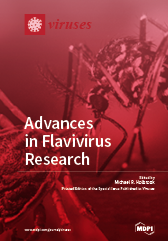Advances in Flavivirus Research
A special issue of Viruses (ISSN 1999-4915). This special issue belongs to the section "Animal Viruses".
Deadline for manuscript submissions: closed (1 December 2016) | Viewed by 120278
Special Issue Editor
Interests: yellow fever virus; tick-borne encephalitis virus; Nipah virus; cell mediated immunity; virus-host cell interactions
Special Issue Information
Dear Colleagues,
Members of the genus Flavivirus cause diseases ranging from mild, acute febrile disease to severe neurological or hemorrhagic diseases. With the current outbreaks of Zika and yellow fever virus infections, the interest in these arthropod-borne viruses is exceptionally high. In addition, the progression of dengue vaccines into advanced clinical trials and licensure in some countries marks a historic achievement for the development of vaccines against this disease. While the development of dengue vaccines adds to the array of vaccines available to prevent disease following flavivirus infection, the lack of therapeutics for the treatment of flavivirus infections is a glaring limitation in our ability to manage diseases caused by these viruses. The lack of effective animal models for many flavivirus infections also severely hampers research toward development of medical countermeasures.
In this special issue of Viruses, we aim to assemble a collection of research papers and reviews that highlight critical advancements in our understanding of flavivirus pathogenesis and countermeasure development. Of particular interest are the development of novel animal models, the immune responses to flavivirus infection, virus-host cell interactions to include intracellular signaling and entry/egress processes, vector-host interactions, novel discoveries in flavivirus pathogenesis, vaccine development and advances in medical countermeasure development.
Dr. Michael Holbrook
Guest Editor
Manuscript Submission Information
Manuscripts should be submitted online at www.mdpi.com by registering and logging in to this website. Once you are registered, click here to go to the submission form. Manuscripts can be submitted until the deadline. All submissions that pass pre-check are peer-reviewed. Accepted papers will be published continuously in the journal (as soon as accepted) and will be listed together on the special issue website. Research articles, review articles as well as short communications are invited. For planned papers, a title and short abstract (about 100 words) can be sent to the Editorial Office for announcement on this website.
Submitted manuscripts should not have been published previously, nor be under consideration for publication elsewhere (except conference proceedings papers). All manuscripts are thoroughly refereed through a single-blind peer-review process. A guide for authors and other relevant information for submission of manuscripts is available on the Instructions for Authors page. Viruses is an international peer-reviewed open access monthly journal published by MDPI.
Please visit the Instructions for Authors page before submitting a manuscript. The Article Processing Charge (APC) for publication in this open access journal is 2600 CHF (Swiss Francs). Submitted papers should be well formatted and use good English. Authors may use MDPI's English editing service prior to publication or during author revisions.
Keywords
- Cell-mediated response to flavivirus infection
- Flavivirus animal models
- Flavivirus vector interactions
- Yellow fever virus
- Zika virus
- Tick-borne encephalitis virus
- Japanese encephalitis virus
- West Nile encephalitis
- Therapeutics for flavivirus infection
- Flavivirus vaccines







